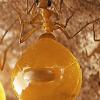It seems people have trouble raising M. Mexicanus so I don't know how long this journal will last but I'll document the entire process.
After the last vestiges of Hurricane Dolores pelted California, I made my way out to 29 Palms on July 20 to try and dig up some queens.
I managed to find two M. Mexicanus queens at 29 Palms along with four P. Rugosus queens.
This is what a typical M. Mexicanus queen sign looks like.
A round outer circle with usually a smaller inner circle.

The first queen I managed to dig up at 29 Palms was dying though. I dug her up completely intact and she just was feebly waving her legs dying for the two hours I kept her in a container. Put her out of her misery and gave her to a foraging P. Rugosus worker.

On my way home, I decided to stop at another random spot and picked up a few more along with a few more from my yard.
All in all, I ended up with 13 M. Mexicanus queens.
Some close ups of the queens.


I came home and realized I was in a bit of trouble considering I was out of test tubes.
So I put three of the M. Mexicanus queens in test tubes in order to spread queens out over different set ups.
Queens 1-4 (from left to right) are some kind of honey pot ant but not M. Mexicanus. Queens 5-7 are M. Mexicanus. Queens 8 is a P. Rugosus.
All three M. Mexicanus queens have a clutch of eggs and seem to be doing well.

Having read other people's journals, it seemed these queens did best in dirt.
The only dirt setup I had made at this point was an experiment and I was planning on giving it to my P. Californicus queen since she was having so much trouble starting her colony but I had given her dirt in her test tube and this set up had just sat there. Seemed like a good opportunity to test it out.
Painter's Storage Cup Setup
Basically, all I had done was put one of the smallest cups inside the biggest cup and surround it with sand dirt. Then I stuffed the small cup with cotton balls and wet them. Poked a little hole in the sand dirt for the queen as well.
The queen didn't like this set up too much at first. I suspect it was because it was a bit tight for her big gaster since this was originally for a P. Californicus so I could feed her. She dug out the hole a bit but she just kind of stood there doing a handstand all day.
Who know's? Maybe she just liked getting that head rush from all the blood going to her head.
She did lay a small clutch of eggs though, visible in the picture at the bottom of that hole where her head is.

But almost one week later, this is what she ended up with.
A small chamber at the very bottom with a clutch of eggs she cares for.
Queen and eggs are barely visible. Queen is on the left side of the chamber. Eggs on the right in kind of a yellow flat, spread out pile.
She's doing pretty well in here. This picture was taken on July 26.

Tic Tac Box Setup
A lot of these queens were still sitting in the Tic Tac boxes I used to store them after digging them up.
I put a small piece of wet, rolled up paper towel or a small cotton ball in there with each of them and they begun laying eggs.

I decided to clean up their Tic Tac boxes and just let them raise their brood in there for now since I lack test tubes anyhow.
I bought more cotton balls so I took out whatever was in there and replaced it with a new moistened cotton ball at the flap part of the Tic Tac box and gave each queen a drop of byFormica Suburst. Most of the queens were really hungry.

Close ups of the queens
Most of the queens keep their eggs in nice, neat piles. All except the right queen...

Close up of the other four queens
All of these queens also have a clutch of eggs, some which you can see. I'm just horrible at taking pictures and trying to get glare out of my photos.

Having revisited the other M. Mexicanus journals, it seems M. Mexicanus has a habit of letting their eggs dry out and die.
If you see the first picture where the seven queens are all together in their Tic Tac boxes, they're in the larger plastic box the Tic Tac boxes come in. I'm considering filling the rest of the space with some moistened cotton balls to raise the humidity to prevent drying. What do you guys think?
Big Box Setup
I originally bought these boxes to house M. Mexicanus queens but ended up giving most of the boxes to my P. Rugosus as can be seen in the journal. I wanted to try out a couple of M. Mexicanus queens in the dirt Tic Tac box set up but I didn't think they'd fare well in there with their larger size so was going to use the bigger boxes...but eh...
Just like the P. Rugosus, I set it up so there was a lot of dirt piled up on one side with a hole in the corner for them to start nesting.
I also put a moist cotton ball in there which I also later removed due to condensation.
The queens just kind of sat there. They had already laid eggs in their empty Tic Tac box setup from before. I moved the eggs in first and once they found them, they started to clean them but that was it. No other movement or desire to look around.
Moved these queens in on July 24th.

One day later, this is what the box looks like.
Instead of using the hole in the corner I gave them, left queen dug out a small hole in the middle and brought her eggs in.
Right queen simply moved down to the least elevated part with dirt and brought her eggs to rear there. No real attempt at digging.
I was thinking that I piled too much dirt on the higher part and they'd have trouble moving around there. Seems I may have been right.

Anyways, that's it for now. Will update more in the following days.
Thanks for stopping by and reading.
Edited by stuhrike, May 18 2021 - 7:25 PM.































